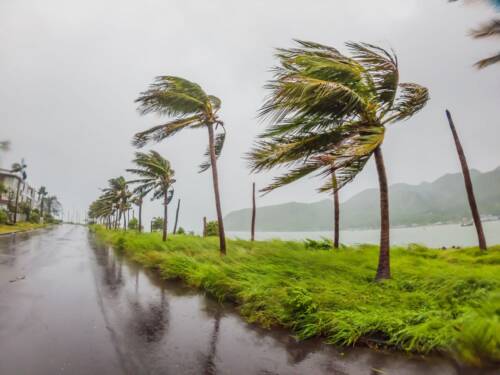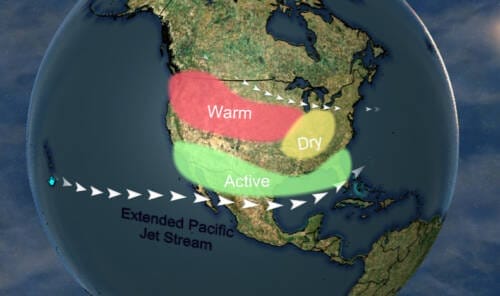Navigating the El Niño to La Niña Transition
Understanding the difference between El Niño and La Niña is critical for businesses and government organizations worldwide. These climatic phenomena can significantly influence weather patterns, impacting various sectors from agriculture to energy. As climate change continues to exacerbate the intensity and frequency of extreme weather events, the ability to anticipate and respond to these shifts becomes increasingly vital. In this post, we’ll delve into the nature of El Niño and La Niña, examine the current transition, and explore the implications for key industries. Additionally, we’ll highlight how advancements in weather forecasting, particularly those offered by Climavision, can help mitigate risks associated with these climatic changes.

Understanding El Nino and La Nina
To fully appreciate the current climatic transitions and their broader implications, it is essential to understand the fundamental characteristics and historical context of El Niño and La Niña.
El Nino
- Characteristics: El Niño is characterized by the warming of ocean surface temperatures in the central and eastern Pacific. This phenomenon disrupts the typical trade winds, altering weather patterns globally.
- Typical Weather Patterns: During El Niño, the southern United States and Peru often experience increased rainfall, which can lead to severe flooding. Conversely, regions like Australia and Indonesia may suffer from drought conditions, exacerbating water shortages and increasing the risk of wildfires.
- Hurricane Season Impacts: Due to strong westerly winds at upper levels of the atmosphere, the tropical Atlantic experiences an increase in total vertical wind shear, working to prevent the maturation of tropical systems.

La Nina
- Characteristics: La Niña, on the other hand, is marked by cooler ocean temperatures in the same regions of the Pacific. This cooling effect strengthens the trade winds, further impacting global weather patterns.
- Typical Weather Patterns: La Niña generally brings increased rainfall to Australia and Indonesia, boosting agricultural productivity but also raising the risk of flooding. In contrast, the southern United States typically sees drier conditions, potentially leading to droughts and impacting water resources.
- Hurricane Season Impacts: Unlike an El Nino year, the westerly winds weaken which reduces the amount of vertical wind shear and allows further hurricane development and intensification.

Historical Context and Frequency
El Niño and La Niña events are part of a larger climate phenomenon known as the El Niño-Southern Oscillation (ENSO) cycle. These events occur irregularly, every two to seven years, and can last from several months to a couple of years. Historically, these cycles have had profound effects on global weather patterns, influencing everything from monsoon rains to hurricane activity.
The Current Transition
The upcoming transition from El Niño to La Niña is a significant meteorological event with far-reaching implications. Understanding the timeline and immediate impacts of this shift can help businesses and governments better prepare and respond.
Timeline of the Transition
Since the spring of 2023, El Niño has been present, but that just changed mid-June 2024. Meteorological data indicated a gradual cooling of ocean temperatures in the central and eastern Pacific, a clear sign of La Niña’s emergence. We are now in a “neutral phase” referred to as ENSO Neutral.
According to the National Oceanic Atmospheric Association (NOAA), there’s now a 65% chance that La Niña will develop between June and August. NOAA still thinks by November 2024 to January 2025, there’s an 85% chance a La Niña will be in effect. The tropical Pacific Ocean continues to trend toward a La Niña phase, coming out of one of the strongest El Niño events on record since 1950.
Meteorological Data and Predictions
Advanced climate models and real-time data collection have enabled meteorologists to predict the onset and development of La Niña with greater accuracy. These models use a combination of ocean temperature measurements, atmospheric data, and historical trends to forecast the duration and potential impacts of La Niña.
Immediate Climatic Impacts Observed
- Global Weather Patterns: The shift to La Niña will likely lead to noticeable changes in global weather patterns. These include altered precipitation rates, temperature anomalies, and shifts in storm activity.
- Specific Regional Examples:
- Southeast Asia: Increased rainfall may lead to significant flooding in regions like Indonesia and Malaysia, disrupting communities and economies.
- Southern United States: Drier conditions in past La Niña’s have exacerbated drought in states such as Texas and California, impacting agriculture and water resources, while an increase in Atlantic hurricane activity also poses a threat
- Australia: La Niña can bring above-average rainfall, benefiting agriculture but also raising the risk of floods in certain areas.
Implications for Business and Government
The transition from El Niño to La Niña has profound implications across various sectors. Understanding these impacts is crucial for effective planning and mitigation.
Agriculture
Agriculture is highly sensitive to changes in weather patterns. The altered rainfall distribution can significantly affect crop yields. In regions that experience increased rainfall, such as Southeast Asia and Australia, crops may benefit from the abundance of water. However, excessive rainfall can also lead to soil erosion and crop damage. Conversely, areas facing drier conditions, like the southern United States, may see reduced crop yields due to insufficient water supply, impacting food production and prices.
Energy Sector
The energy sector, particularly hydroelectric power, is directly influenced by precipitation patterns. Increased rainfall in regions with significant hydroelectric infrastructure can boost power generation. However, too much water can overwhelm dams and reservoirs, leading to operational challenges. In drought-affected areas, reduced water flow can diminish hydroelectric output, necessitating a greater reliance on other energy sources.
Insurance
The insurance industry must contend with the increased risk of natural disasters during La Niña events. La Niña conditions often correlate with higher hurricane activity in the Atlantic. This leads to more insurance claims from storm damage, affecting the financial stability of insurers and policyholders. Insurers must adjust their risk models and prepare for a higher volume of claims.
Disaster Preparedness and Response
Government agencies and disaster response organizations need to be on high alert during La Niña. The heightened risk of floods, droughts, and hurricanes necessitates robust disaster preparedness plans. Effective response strategies, early warning systems, and resource allocation are critical to mitigating the impact of these natural events on communities and infrastructure.
Advancements in Weather Forecasting to Help Mitigate La Nina Risk
To address the challenges posed by La Niña, advancements in weather forecasting are essential. Climavision is at the forefront of these innovations, offering state-of-the-art solutions to enhance forecasting accuracy and reliability.
More Global Observations
Enhanced observational data is crucial for accurate real-time weather monitoring. Unfortunately, most weather providers rely on the same standard government sources for weather data. Climavision breaks from this mold by capturing 1.5 billion global observational datasets daily as well as rapidly assimilating new and novel third-party datasets. By gathering unique observational data from multiple sources, including space-based platforms and a high-resolution radar network, Climavision fuels a range of weather monitoring and prediction solutions.
Additionally, Climavision elevates the amount of usable data that is collected when compared to standard government sources. By leveraging cutting edge data assimilation techniques, Climavision increases the amount of usable data from the typical 3% to over 20%, ensuring a more comprehensive understanding of weather patterns.
More Advanced Numerical Weather Predictions (NWPs)
Numerical Weather Prediction (NWP) models are the backbone of weather forecasting. Superior NWP models are essential for accurate weather predictions. These models simulate the atmosphere’s behavior, taking into account various factors such as temperature, humidity, and wind. It’s important to note that currently AI alone still cannot replicate NWP models as it does not understand physics.
Climavision’s NWP models are mathematically superior, meticulously calibrated to account for evolving extreme weather patterns. Fueled with more and unique observational data, these models can more accurately forecast major events like hurricanes, benefitting multiple business sectors by enabling companies to plan more effectively.
AI Forecasting
Artificial Intelligence (AI) is revolutionizing weather forecasting. AI enhances forecast accuracy and extends predictive time horizons, enabling more precise predictions for critical weather events across all time scales.
Climavision leverages the latest AI advancements to offer ensemble forecasts, providing probabilistic breakdowns of different outcome likelihoods. Our proprietary approach to AI allows for explainable, highly accurate forecasts tailored to specific use cases, delivered with greater speed and verified accuracy. Whether you’re predicting weather two hours or two years in advance, Climavision’s AI technology ensures businesses and governments have the information they need to make informed decisions.
Leverage Advanced Forecasting Technologies
The transition from El Niño to La Niña presents significant challenges and opportunities for proactive planning and adaptation. By understanding these implications and leveraging advanced weather forecasting technologies, businesses and government organizations can better anticipate and mitigate the associated risks. Climavision’s innovative solutions, encompassing enhanced observational data, superior NWP models, and cutting-edge AI forecasting, provide the tools necessary for effective risk management. For more information on how Climavision can support your weather forecasting needs, contact us.




